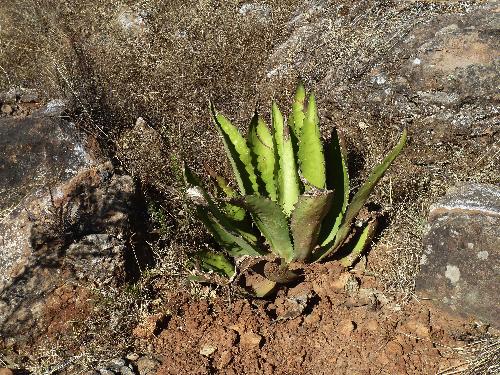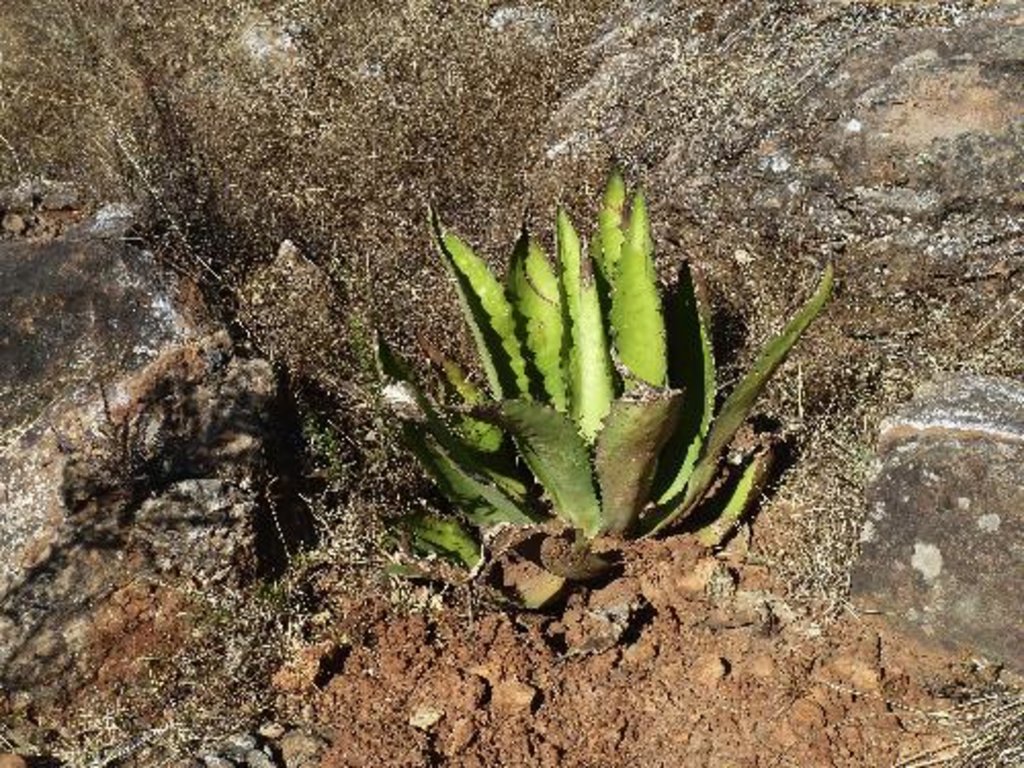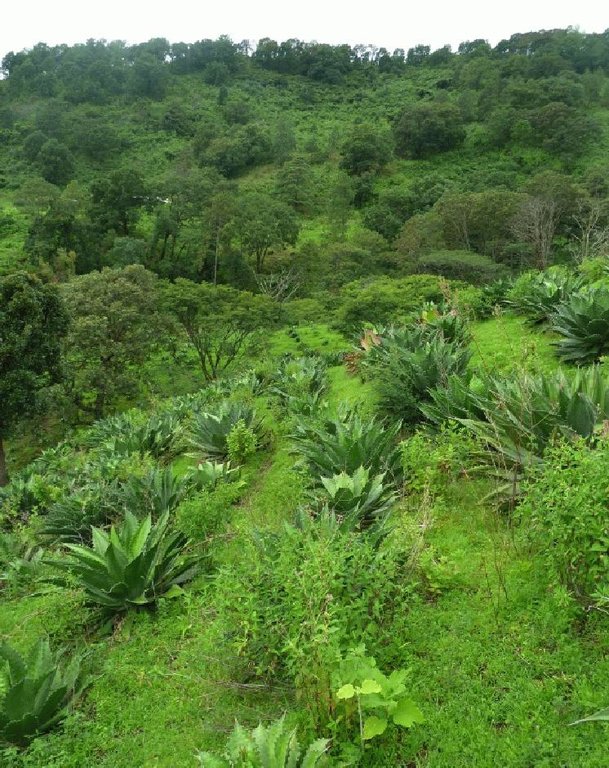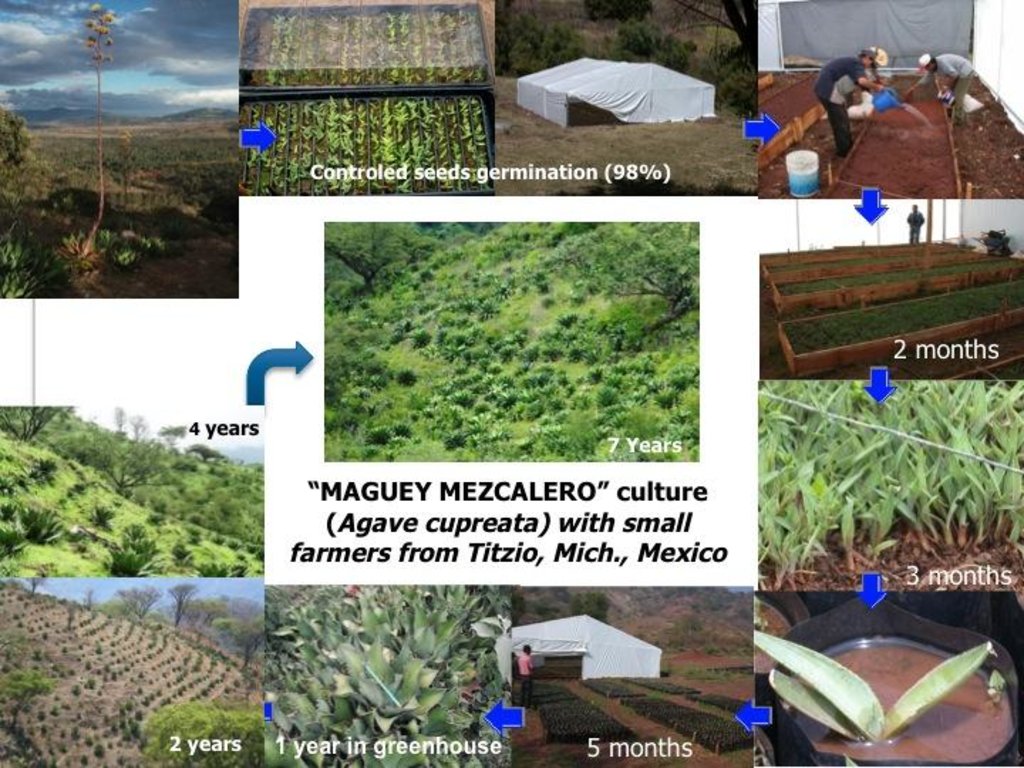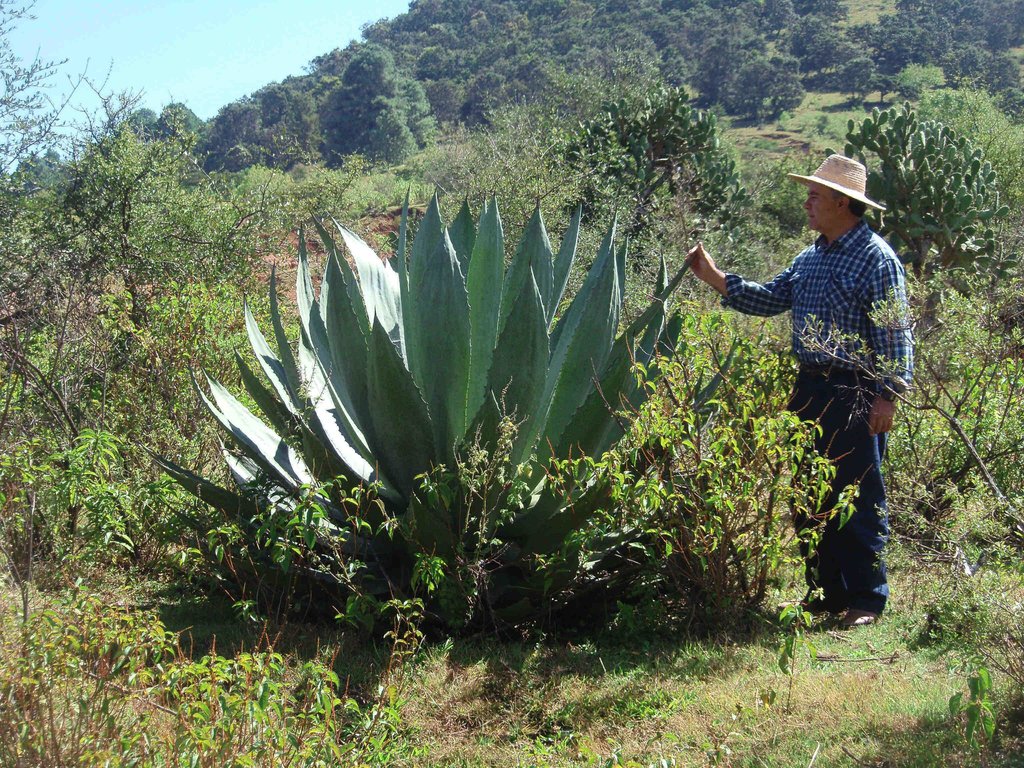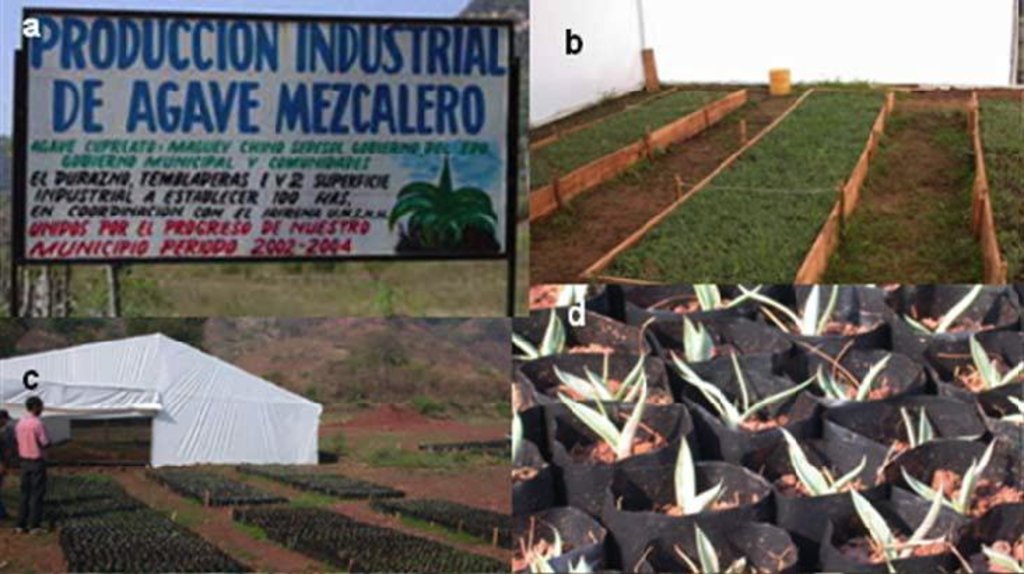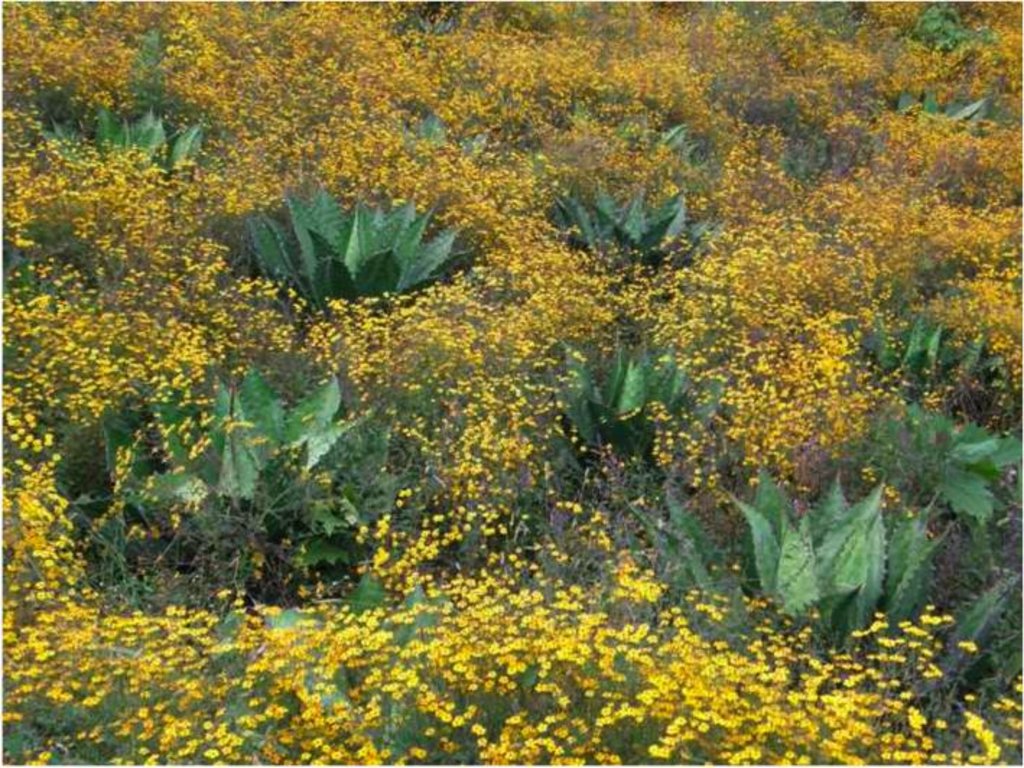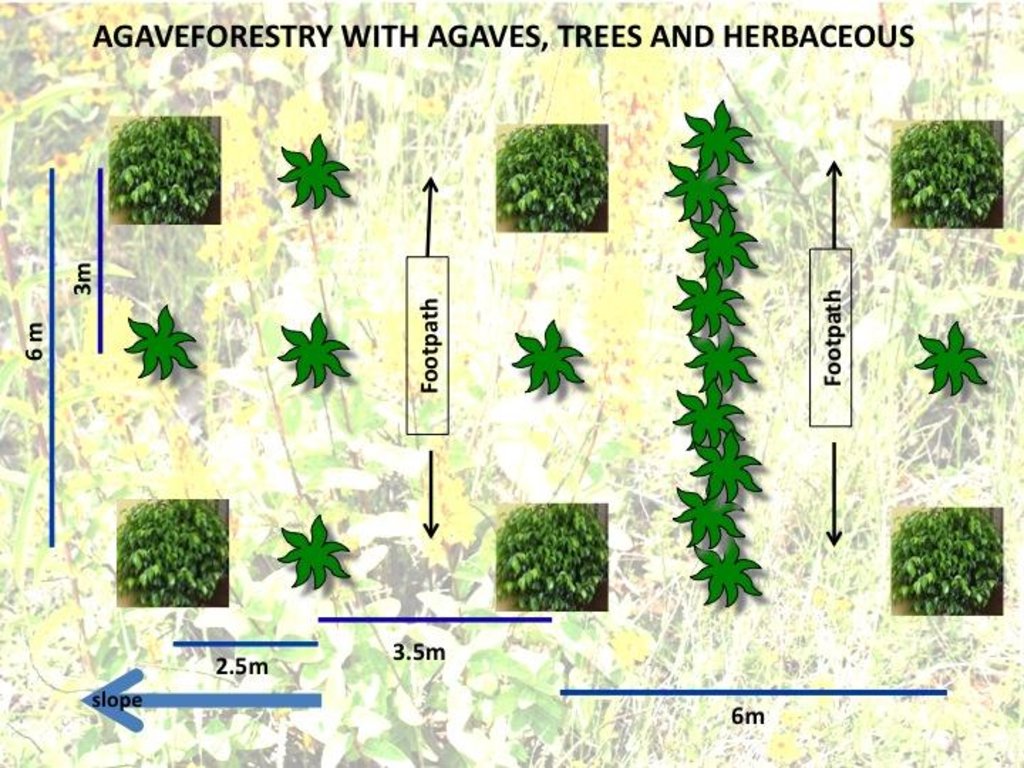Land reclamation by agave forestry with native species [ប្រទេសម៉ិកស៊ិក]
- ការបង្កើត៖
- បច្ចុប្បន្នភាព
- អ្នកចងក្រង៖ Christian Prat
- អ្នកកែសម្រួល៖ –
- អ្នកត្រួតពិនិត្យ David Streiff
Recuperación de tierras degradadas por agaveforestería con especies locales de agaves, arboles y herbaceas (Spanish)
technologies_1114 - ប្រទេសម៉ិកស៊ិក
ពិនិត្យមើលគ្រប់ផ្នែក
ពង្រីកមើលទាំងអស់ បង្រួមទាំងអស់1. ព័ត៌មានទូទៅ
1.2 ព័ត៌មានលម្អិតពីបុគ្គលសំខាន់ៗ និងស្ថាប័នដែលចូលរួមក្នុងការវាយតម្លៃ និងចងក្រងឯកសារនៃបច្ចេកទេស
អ្នកជំនាញឯកទេស SLM:
Martínez Palacios Alejandro
(443) 334-0475
apalacios56@gmail.com
Instituto de Investigaciones Agropecuarias y Forestales, Universidad Michoacana de San Nicolás de Hidalgo
km 9.5 carr. Morelia-Zinapecuaro, Tarímbaro, Michoacán 58330
ប្រទេសម៉ិកស៊ិក
អ្នកជំនាញឯកទេស SLM:
Ríos Patrón Eduardo
(443) 322-6017
eduardo.rios@semarnat.gob.mx
Delegación de SEMARNAT en Michoacán, Unidad de Planeación y Política Ambiental
Morelia, Michoacán
ប្រទេសម៉ិកស៊ិក
ឈ្មោះគម្រោងដែលបានចងក្រងឯកសារ/ វាយតម្លៃលើបច្ចេកទេស (បើទាក់ទង)
DESIRE (EU-DES!RE)ឈ្មោះអង្គភាពមួយ (ច្រើន) ដែលបានចងក្រងឯកសារ/ វាយតម្លៃបច្ចេកទេស (បើទាក់ទង)
Instituto de Investigaciones Agropecuarias y Forestales (IIAF) - ប្រទេសម៉ិកស៊ិកឈ្មោះអង្គភាពមួយ (ច្រើន) ដែលបានចងក្រងឯកសារ/ វាយតម្លៃបច្ចេកទេស (បើទាក់ទង)
Institut de recherche pour le développement IRD (Institut de recherche pour le développement IRD) - ប្រទេសបារាំងឈ្មោះអង្គភាពមួយ (ច្រើន) ដែលបានចងក្រងឯកសារ/ វាយតម្លៃបច្ចេកទេស (បើទាក់ទង)
SECRETARÍA DE MEDIO AMBIENTE Y RECURSOS NATURALES (SECRETARÍA DE MEDIO AMBIENTE Y RECURSOS NATURALES) - ប្រទេសម៉ិកស៊ិកឈ្មោះអង្គភាពមួយ (ច្រើន) ដែលបានចងក្រងឯកសារ/ វាយតម្លៃបច្ចេកទេស (បើទាក់ទង)
Universidad Michoacana de San Nicolás de Hidalgo (UMSNH) - ប្រទេសម៉ិកស៊ិក1.3 លក្ខខណ្ឌទាក់ទងទៅនឹងការប្រើប្រាស់ទិន្នន័យដែលបានចងក្រងតាមរយៈ វ៉ូខេត
តើពេលណាដែលទិន្នន័យបានចងក្រង (នៅទីវាល)?
01/10/2010
អ្នកចងក្រង និង(បុគ្គលសំខាន់ៗ)យល់ព្រមទទួលយកនូវលក្ខខណ្ឌនានាទាក់ទងទៅនឹងការប្រើប្រាស់ទិន្នន័យដែលបានចងក្រងតាមរយៈវ៉ូខេត:
បាទ/ចា៎
1.5 ការយោងទៅលើកម្រងបញ្ជីសំណួរនៃវិធីសាស្ត្រផ្សព្វផ្សាយ SLM
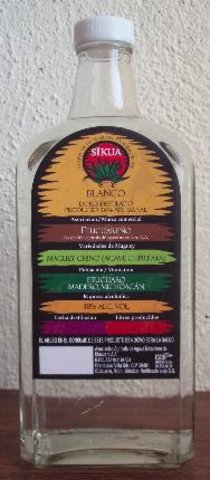
Participative actions for economic benefits of agave forestry [ប្រទេសម៉ិកស៊ិក]
Land reclamation with local agave (to produce Mezcal) associated with trees, shrubs and grasses planted through participative actions for economic benefit.
- អ្នកចងក្រង៖ Christian Prat
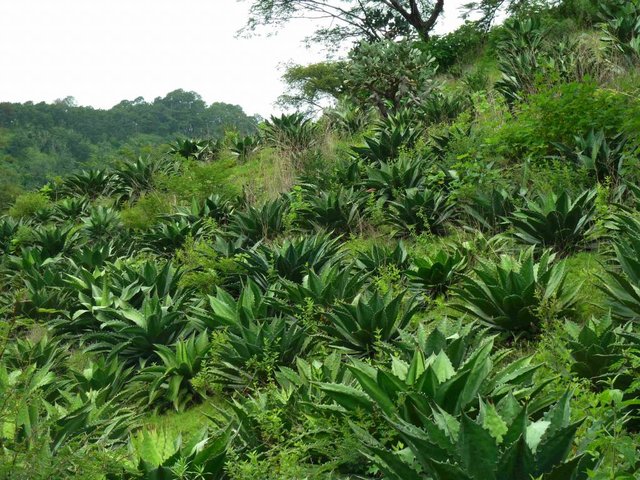
Land reclamation by agave forestry with native species [ប្រទេសម៉ិកស៊ិក]
Land reclamation with local agave (to produce mezcal) associated wotj trees, shrubs and grasses planted through participative actions for economic benefit.
- អ្នកចងក្រង៖ Christian Prat
2. ការពណ៌នាពីបច្ចេកទេស SLM
2.1 ការពណ៌នាដោយសង្ខេបពីបច្ចេកទេស
និយមន័យបច្ចេកទេស:
Agave forestry land reclamation system with native agaves, trees, shrubs and grasses planted through participatory action for a sustainable production of mezcal and other products in order to generate high incomes for farmers.
2.2 ការពណ៌នាលម្អិតពីបច្ចេកទេស
ការពណ៌នា:
Rehabilitation of degraded land is achieved using native agave (Agave inaequidens), trees and/or fruit trees, shrubs and grasses to create, over the medium-term (7-10 years), sustainable production of a traditional alcoholic drink (mezcal) made from agave and/or cosmetic and medicinal products, and/or fibres and/or fodder for cattle and/or wood. Between the agave plants, native vegetation is managed or planted for use as food, fodder and/or medicinal products. Depending on the slope and the level of land degradation, continuous planted rows of agave provide a ’green’ barrier that controls soil erosion and runoff.
Purpose of the Technology: The main purpose is to achieve sustainable land rehabilitation while generating a high income for the farmer. This allows reducing the amount of livestock and overgrazing, which is the main cause of soil erosion in this region. The production of mezcal gives local farmers high incomes. Trees, shrubs and grasses for medicinal uses, food, and fodder are complements of agave production and are processed mainly by women, while agave harvesting is a male activity. As it is very attractive financially, farmers stay in the communities instead of emigrating to cities or abroad. Biodiversity is preserved and increased using native plants (agaves, trees, shrubs, grasses). These plant associations are effective at controlling plant pests and diseases. Turning eroded into productive soil sequesters carbon and increases water availability as a result of the new soil cover.
Establishment / maintenance activities and inputs: Unlike most agave, Agave inaequidens reproduces from seed, which requires harvesting the seeds from native plants in the fields. One plant generates 80,000 seeds with a 90% success rate of germination, which is enough to cover 25 ha of agave forestry plantations set up to control soil erosion. After harvesting seeds from native agaves, trees and shrubs, seedlings and small plants are raised in a greenhouse and nursery managed by the owners and tenants of the land in the first year. At the beginning of the rainy season, these are planted in plots protected from cattle grazing for at least the first two years after planting. The harvesting activity for trees, shrubs and grasses is done annually, but for the agaves only once every 7 to 12 years depending on the degree of soil degradation. Some months before harvesting, the flower from the stem has to be cut. The leaves are then cut and left in the plot while the 50 kg heart of the agave (“piña”) is removed. Mezcal is produced from the heart and requires an average of three weeks and at least two men to process 25 agave plants (1.5 tonnes), which produces about 300 litres of mezcal.
Natural / human environment: Poverty levels in the area are medium to high and the income from agriculture accounts for only 10 to 20% of the total family budget. People, therefore, do not have time to install soil erosion protection systems in the fields. Cattle graze freely everywhere and the number of animals is increasing annually, which also increases soil erosion. Locals know how to produce mezcal, but they prefer to buy it from other people who take wild plants from their lands to process them. The proximity of the site to the Michoacán of Ocampo state capital and the recognition of the designation of origin for mezcal by the authorities will enhance its value for future production.
2.3 រូបភាពនៃបច្ចេកទេស
2.5 ប្រទេស/តំបន់/ទីតាំងកន្លែង ដែលបច្ចេកទេសត្រូវបានអនុវត្ត និងបានគ្រប់ដណ្តប់ដោយការវាយតម្លៃនេះ
ប្រទេស:
ប្រទេសម៉ិកស៊ិក
តំបន់/រដ្ឋ/ខេត្ត:
Mexico/Michoacán state
បញ្ជាក់បន្ថែមពីលក្ខណៈនៃទីតាំង:
Morelia municipality
Map
×2.6 កាលបរិច្ឆេទនៃការអនុវត្ត
ប្រសិនបើមិនច្បាស់ឆ្នាំ សូមបញ្ជាក់កាលបរិច្ឆេទដែលប្រហាក់ប្រហែល:
- 10-50 ឆ្នាំ
2.7 ការណែនាំពីបច្ចេកទេស
មតិយោបល់ (ប្រភេទនៃគម្រោង ។ល។):
10 years ago, at Titzio, close to Cointzio basin, A. Martinez developped the culture of a wild native agave (Agave Cupreata) for alcohol production which was done traditionnaly for local consumming. We are following this project and objectives, but we are improving it for land remediation and soil erosion control too with a new species of native Agave (A. inaequidens)
3. ចំណាត់ថ្នាក់នៃបច្ចេកទេស SLM
3.1 គោលបំណងចម្បង (១ ឬច្រើន) នៃបច្ចេកទេសនេះ
- កាត់បន្ថយ, បង្ការ, ស្តារឡើងវិញនូវការធ្លាក់ចុះគុណភាពដី
- បង្កើតផលប្រយោជន៍សេដ្ឋកិច្ច
3.2 ប្រភេទដីប្រើប្រាស់មួយប្រភេទ (ច្រើនប្រភេទ) ដែលបានអនុវត្តបច្ចេកទេស

ចម្រុះ (ដំណាំ/ វាលស្មៅ/ ដើមឈើ)គិតទាំងកសិរុក្ខកម្ម
- ដីដាំដំណាំ និងចិញ្ចឹមសត្វ
- ដាំដំណាំ ចិញ្ចឹមសត្វ និងឈើ
ផលិតផល/សេវាកម្មចម្បង:
semi perennial cropping (7-10 years): Agave inaequidens
annual: Herbaceous
tree cropping: Wood, fodder and fruits
មតិយោបល់:
Major land use problems (compiler’s opinion): Mainly overgrazing due to uncontrolled grazing by cattle.
Major land use problems (land users’ perception): Soil erosion by water due to the storms and improper land use.
Semi-nomadism / pastoralism: Yes
Forest products and services: timber, fuelwood, grazing / browsing, other forest products / uses (honey, medical, etc.), nature conservation / protection
Future (final) land use (after implementation of SLM Technology): Mixed: Mf: Agroforestry
ប្រសិនបើដីមានការប្រែប្រួលបន្ទាប់ពីការអនុវត្តបច្ចេកទេស សូមបញ្ជាក់ពីការប្រើប្រាស់ដីមុនពេលអនុវត្តន៍បច្ចេកទេស:
Grazing land: Ge: Extensive grazing land
3.3 ព័ត៌មានបន្ថែមអំពីអ្នកប្រើប្រាស់ដី
ការផ្គត់ផ្គង់ទឹកនៅកន្លែងអនុវត្តបច្ចេកទេស:
- ទឹកភ្លៀង
ចំនួនសារដែលដាំដំណាំក្នុងមួយឆ្នាំ:
- 1
សូមបញ្ជាក់:
Longest growing period in days: 190; Longest growing period from month to month: June to November
ដង់ស៊ីតេនៃសត្វចិញ្ចឹម (បើពាក់ព័ន្ធ):
1-10 LU /km2
3.4 ក្រុម SLM ដែលបច្ចេកទេសស្ថិតនៅក្នុង
- ធ្វើឱ្យប្រសើរឡើងគម្របដី/ ដំណាំគម្របដី
- វិធានការអនុវត្តកាត់ទទឹងទីជម្រាល
- ធ្វើឱ្យប្រសើរឡើងនូវការបង្កាត់ពូជរុក្ខជាតិ/ សត្វ
3.5 ការសាយភាយនៃបច្ចេកទេស
បញ្ជាក់ពីការសាយភាយនៃបច្ចេកទេស:
- ត្រូវបានផ្សព្វផ្សាយត្រឹមតំបន់មួយ
ប្រសិនបើបច្ចេកទេសត្រូវបានសាយភាយពាសពេញតំបន់ណាមួយ សូមកំណត់ទំហំផ្ទៃដីអនុវត្តន៍:
- 0.1-1 គម2
មតិយោបល់:
630 km2 is the area of the Cointzio watershed. Untill now (2010), 10 ha have been managed with this technics and from 2011, 50 ha/year will be done (at least)
3.6 វិធានការ SLM ដែលបញ្ចូលនូវបច្ចេកទេស

វិធានការក្សេត្រសាស្ត្រ
- A1: ដំណាំ/គម្របដី

វិធានការរុក្ខជាតិ
- V1: ឈើធំៗ និងដើមឈើតូចៗ

វិធានការរចនាស័ម្ពន្ធ
- S11: ផ្សេងៗ

វិធានការគ្រប់គ្រង
- M3: ប្លង់យោងទៅតាមធម្មជាតិ និងបរិស្ថានធម្មជាតិ
មតិយោបល់:
Secondary measures: agronomic measures, management measures
Type of agronomic measures: better crop cover, mixed cropping / intercropping, contour planting / strip cropping, cover cropping, retaining more vegetation cover, breaking compacted topsoil, contour ridging, breaking compacted subsoil
Type of vegetative measures: aligned: -contour
3.7 កំណត់ប្រភេទនៃការធ្លាក់ចុះគុណភាពដីសំខាន់ៗដែលបច្ចេកទេសនេះបានដោះស្រាយ

ការហូរច្រោះដីដោយសារទឹក
- Wt: ការបាត់ដីស្រទាប់លើដោយការហូរច្រោះ
- Wg: ការកកើតឡើងនូវកំទេចកំទីដីស្រទាប់ក្រោម

ការបាត់បង់រូបសាស្ត្រនៃដី
- Pu: បាត់បង់នូវផលិតភាពជីវៈដោយសារសកម្មភាពផ្សេងៗ

ការធ្លាក់ចុះជីវសាស្ត្រនៃដី
- Bc: ការថយចុះនូវគម្របរុក្ខជាតិ
- Bq: ការថយចុះនូវជីវម៉ាស/ បរិមាណ
- Bs: សមាសភាពដែលមានគុណភាពនិងប្រភេទសត្វ/ការថយចុះនូវជីវចម្រុះ

ការបាត់បង់ទឹក
- Hs: ការប្រែប្រួលបរិមាណទឹកនៅលើផ្ទៃដី
មតិយោបល់:
Secondary types of degradation addressed: Pu: loss of bio-productive function due to other activities, Bq: quantity / biomass decline, Hs: change in quantity of surface water
Main causes of degradation: soil management (System of one year culture/one year fallow with cattle), overgrazing (THE real cause of soil erosion here), poverty / wealth (Cattle is used as a "bank on 4 feet")
Secondary causes of degradation: crop management (annual, perennial, tree/shrub), deforestation / removal of natural vegetation (incl. forest fires), over-exploitation of vegetation for domestic use (Untill 30 years ago, some wood was used for carbon used for cooking), population pressure
3.8 ការពារ កាត់បន្ថយ ឬស្តារឡើងវិញនៃការធ្លាក់ចុះគុណភាពដី
បញ្ជាក់ពីគោលដៅរបស់បច្ចេកទេស ដែលផ្តោតទៅការធ្លាក់ចុះគុណភាពដី:
- ការជួសជុល/ ស្តារឡើងវិញនៃឱនភាពដីធ្ងន់ធ្ងរ
មតិយោបល់:
Secondary goals: prevention of land degradation, mitigation / reduction of land degradation
4. បច្ចេកទេសជាក់លាក់ សកម្មភាពអនុវត្ត ធាតុចូល និងថ្លៃដើម
4.1 គំនូសបច្ចេកទេសនៃបច្ចេកទេសនេះ
4.2 លក្ខណៈពិសេសនៃបច្ចេកទេស/ ពណ៌នាពីគំនូរបច្ចេកទេស
Agave production is based on planting them with trees along the contour. Herbs are maintained / planted or sown between the plants. Depending on the slope, one or more dense lines of agaves (1 plant every 25 cm) is planted for control of soil erosion and runoff, including a lateral gradient to the gully which will evacuate the excessive runoff. Footpaths are planned for the maintenance of the plantation
Location: Michoacán. Mexico
Date: 2010
Technical knowledge required for field staff / advisors: low (low for reproduction, plantation and cultivation and middle for alcohol production)
Technical knowledge required for land users: low (low for reproduction, plantation and cultivation and middle for alcohol production)
Main technical functions: control of dispersed runoff: retain / trap, control of concentrated runoff: retain / trap, improvement of ground cover, improvement of surface structure (crusting, sealing), improvement of topsoil structure (compaction), improvement of subsoil structure (hardpan), increase of infiltration, sediment retention / trapping, sediment harvesting, increase of biomass (quantity), promotion of vegetation species and varieties (quality, eg palatable fodder)
Secondary technical functions: control of raindrop splash, control of dispersed runoff: impede / retard, control of concentrated runoff: impede / retard, control of concentrated runoff: drain / divert, reduction of slope angle, reduction of slope length, increase of surface roughness, stabilisation of soil (eg by tree roots against land slides), increase in organic matter, increase in nutrient availability (supply, recycling,…), increase / maintain water stored in soil, increase of groundwater level / recharge of groundwater, water harvesting / increase water supply, water spreading, improvement of water quality, buffering / filtering water, spatial arrangement and diversification of land use
Better crop cover
Material/ species: Agave inaequidens+native trees+herbaceous
Quantity/ density: 830/270
Remarks: Agaves/Trees per ha
Mixed cropping / intercropping
Material/ species: Agave inaequidens+native trees+herbaceous
Quantity/ density: 830/270
Remarks: Agaves/Trees per ha
Contour planting / strip cropping
Material/ species: Agave inaequidens+native trees+herbaceous
Quantity/ density: 830/270
Remarks: Agaves/Trees per ha
Cover cropping
Material/ species: Native trees+herbaceous
Agronomic measure: Herbaceous
Material/ species: Native herbaceous
Agronomic measure: Leafs from trees
Material/ species: Native trees
Quantity/ density: 270
Remarks: Trees per ha
Breaking compacted topsoil
Material/ species: Agave inaequidens+native trees+herbaceous
Quantity/ density: 830/270
Remarks: Agaves/Trees per ha
Contour ridging
Material/ species: Agave inaequidens+native trees+herbaceous
Quantity/ density: 830/270
Remarks: Agaves/Trees per ha
Breaking compacted subsoil
Material/ species: Agave inaequidens+native trees+herbaceous
Quantity/ density: 830/270
Remarks: Agaves/Trees per ha
Aligned: -contour
Vegetative material: C : perennial crops
Number of plants per (ha): 1200
Spacing between rows / strips / blocks (m): 30
Vertical interval within rows / strips / blocks (m): 0,25
Width within rows / strips / blocks (m): 1
Aligned: -along boundary
Vegetative material: O : other
Vegetative measure: Vegetative material: F : fruit trees / shrubs
Perennial crops species: Agave inaequidens (mature between 7 to 14 years)
Slope (which determines the spacing indicated above): 30%
Gradient along the rows / strips: 30%
Vegetation is used for stabilisation of structures.
Layout change according to natural and human environment: Natives plants are used, planted according to the slopes and the rest of vegetation still existing
4.3 ព័ត៌មានទូទៅដែលពាក់ព័ន្ធនឹងការគណនាធាតុចូល និងថ្លៃដើម
កំណត់របៀបនៃការគណនាថ្លៃដើម និងធាតុចូល:
- ក្នុងតំបន់អនុវត្តបច្ចេកទេស
កំណត់ទំហំ និងឯកត្តាផ្ទៃដី:
100 ha
ផ្សេងៗ/ រូបិយប័ណ្ណជាតិ (បញ្ជាក់):
mexican pesos
កំណត់អត្រាប្តូរប្រាក់ពីដុល្លាទៅរូបិយប័ណ្ណតំបន់ (បើទាក់ទង)៖ 1 ដុល្លារ =:
13,0
កំណត់ថ្លៃឈ្នួលជាមធ្យមនៃការជួលកម្លាំងពលកម្មក្នុងមួយថ្ងៃ:
160
4.4 សកម្មភាពបង្កើត
| សកម្មភាព | ប្រភេទវិធានការ | ពេលវេលា | |
|---|---|---|---|
| 1. | Selection and collect Agave and tree seeds | សារពើរុក្ខជាតិ | 1 week |
| 2. | Building of greenhouses incl. soil and organic matter | សារពើរុក្ខជាតិ | 1 month |
| 3. | Fencing of greenhouses with barbed wire, poles and nails (0.5 ha | សារពើរុក្ខជាតិ | |
| 4. | Seeding & maintaining in greenhouses | សារពើរុក្ខជាតិ | 3 monthes |
| 5. | Installation of a nursery for agaves and trees and transplantation of seedlings in plastic bags | សារពើរុក្ខជាតិ | 2 weeks |
| 6. | Plant care and maintaining in nursery (9 months) | សារពើរុក្ខជាតិ | 9 monthes |
| 7. | Transportation of plants in plastic bags | សារពើរុក្ខជាតិ | |
| 8. | Plantation of plants (agaves and trees) | សារពើរុក្ខជាតិ |
4.5 ថ្លៃដើម និងធាតុចូលដែលត្រូវការសម្រាប់ការបង្កើតបច្ចេកទេស
| បញ្ជាក់ពីធាតុចូល | ឯកតា | បរិមាណ | ថ្លៃដើមក្នុងមួយឯកតា | ថ្លៃធាតុចូលសរុប | % នៃថ្លៃដើមដែលចំណាយដោយអ្នកប្រើប្រាស់ដី | |
|---|---|---|---|---|---|---|
| កម្លាំងពលកម្ម | Building of greenhouses | persons/day | 21,0 | 523,8095 | 11000,0 | |
| កម្លាំងពលកម្ម | Seeding & maintaining in greenhouses | persons/3 months | 2,0 | 5000,0 | 10000,0 | |
| កម្លាំងពលកម្ម | Installation of a nursery for agaves and trees | persons/day | 14,0 | 1071,4285 | 15000,0 | |
| កម្លាំងពលកម្ម | Plant care and maintaining in nursery | persons/9months | 2,0 | 15000,0 | 30000,0 | |
| សម្ភារៈដាំដុះ | Selection and collect Agave and tree seeds | plants | 5,0 | 100,0 | 500,0 | |
| ជី និងសារធាតុពុល | Materials for plant care | months | 9,0 | 2777,7777777 | 25000,0 | |
| សម្ភារៈសាងសង់ | Materials for greenhouse | trees | 60000,0 | 0,056666666 | 3400,0 | |
| សម្ភារៈសាងសង់ | Materials for greenhouse | agave | 200000,0 | 0,035 | 7000,0 | |
| សម្ភារៈសាងសង់ | Materials for fences | m | 1500,0 | 2,4 | 3600,0 | |
| សម្ភារៈសាងសង់ | Materials for nurserys | trees | 60000,0 | 1,5 | 90000,0 | |
| សម្ភារៈសាងសង់ | Materials for nurserys | agaves | 200000,0 | 0,2 | 40000,0 | |
| ថ្លៃដើមសរុបក្នុងការបង្កើតបច្ចេកទេស | 235500,0 | |||||
មតិយោបល់:
Duration of establishment phase: 12 month(s)
4.6 សកម្មភាពថែទាំ
| សកម្មភាព | ប្រភេទវិធានការ | ពេលវេលា/ ភាពញឹកញាប់ | |
|---|---|---|---|
| 1. | Cleaning around plants to give them space the first 3 years (For 1 person 10 days) | ក្សេត្រសាស្ត្រ | 1 time/year |
| 2. | Cutting the scape before the harvest (For 1 person 15 days) | ក្សេត្រសាស្ត្រ | 1 time in agave life (between 7-14 years) |
| 3. | Weeding around plants to give them space during the first 3 years (10 person days) | សារពើរុក្ខជាតិ | 1 time/year |
| 4. | Cutting the stalk before the harvest (15 person days) | សារពើរុក្ខជាតិ | 1 Agavelife time (7 to 14 years old) |
| 5. | Replanting of agaves after 7 to 14 years (restarting of a new cycle of production, see establishment activities) | សារពើរុក្ខជាតិ |
4.7 កំណត់ថ្លៃដើមសម្រាប់ការថែទាំ/ សកម្មភាពរបស់បច្ចេកទេស (ក្នុងរយៈពេលមួយឆ្នាំ)
| បញ្ជាក់ពីធាតុចូល | ឯកតា | បរិមាណ | ថ្លៃដើមក្នុងមួយឯកតា | ថ្លៃធាតុចូលសរុប | % នៃថ្លៃដើមដែលចំណាយដោយអ្នកប្រើប្រាស់ដី | |
|---|---|---|---|---|---|---|
| កម្លាំងពលកម្ម | Weeding around plants | persons/day | 10,0 | 160,0 | 1600,0 | 10,0 |
| កម្លាំងពលកម្ម | Cutting the stalk before the harvest | persons/day | 15,0 | 150,0 | 2250,0 | 10,0 |
| ថ្លៃដើមសរុបសម្រាប់ការថែទាំដំណាំតាមបច្ចេកទេស | 3850,0 | |||||
មតិយោបល់:
Calculations are for the plantation of 200,000 plants (agaves and trees) which correspond to the numbers of plants for 100 ha in the agave forestry example presented here. The main portion of these plants is planted by the community on the own land; the rest is given or sold to other communities or private people. The lifetime of the greenhouse, nursery and fencing installations are around 10 years.
4.8 កត្តាសំខាន់បំផុតដែលមានឥទ្ធិពលដល់ការចំណាយ
ពណ៌នាពីកត្តាប៉ះពាល់ចម្បងៗទៅលើថ្លៃដើម:
The most important factors determining the costs are: 1) the materials to build a greenhouse and the personal to take care of young plants; 2) the difficulties to make holes in the indurated soils, which takes time and efforts; and 3) the distance between the nursery and the field requires time and efforts (truck carrying the plants).
5. លក្ខណៈបរិស្ថានធម្មជាតិ និងមនុស្ស
5.1 អាកាសធាតុ
បរិមាណទឹកភ្លៀងប្រចាំឆ្នាំ
- < 250 មម
- 251-500 មម
- 501-750 មម
- 751-1,000 មម
- 1,001-1,500 មម
- 1,501-2,000 មម
- 2,001-3,000 មម
- 3,001-4,000 មម
- > 4,000 មម
លក្ខណៈពិសេស/ មតិយោបល់លើរដូវភ្លៀង:
Rainy season from june to october
តំបន់កសិអាកាសធាតុ
- មានភ្លៀងតិចតួច
Thermal climate class: subtropics
Thermal climate class: temperate
5.2 សណ្ឋានដី
ជម្រាលជាមធ្យម:
- រាបស្មើ (0-2%)
- ជម្រាលតិចតួច (3-5%)
- មធ្យម (6-10%)
- ជម្រាលខ្ពស់បន្តិច (11-15%)
- ទីទួល (16-30%)
- ទីទួលចោត (31-60%)
- ទីទួលចោតខ្លាំង (>60%)
ទម្រង់ដី:
- ខ្ពង់រាប
- កំពូលភ្នំ
- ជម្រាលភ្នំ
- ជម្រាលទួល
- ជម្រាលជើងភ្នំ
- បាតជ្រលងភ្នំ
តំបន់តាមរយៈកម្ពស់ :
- 0-100 ម
- 101-500 ម
- 501-1,000 ម
- 1,001-1,500 ម
- 1,501-2,000 ម
- 2,001-2,500 ម
- 2,501-3,000 ម
- 3,001-4,000 ម
- > 4,000 ម
បញ្ជាក់ថាតើបច្ចេកទេសនេះត្រូវបានអនុវត្តន៍នៅក្នុង:
- មិនពាក់ព័ន្ធទាំងអស់
មតិយោបល់ និងបញ្ចាក់បន្ថែមអំពីសណ្ឋានដី :
Slopes on average: Also steep, very steep and moderate
Altitudinal zone (2000-2500 m a.s.l.) : The Agave inaequidens grows is this conditions but other spieces of Agaves grow in other agroclimatic conditions
5.3 ដី
ជម្រៅដីជាមធ្យម:
- រាក់ខ្លាំង (0-20 សម)
- រាក់ (21-50 សម)
- មធ្យម (51-80 សម)
- ជ្រៅ (81-120 សម)
- ជ្រៅខ្លាំង (> 120 សម)
វាយនភាពដី (ស្រទាប់លើ):
- មធ្យម (ល្បាយ, ល្បាប់)
- ម៉ត់/ ធ្ងន់ (ឥដ្ឋ)
សារធាតុសរីរាង្គនៅស្រទាប់ដីខាងលើ:
- មធ្យម (1-3%)
- ទាប (<1%)
បើអាចសូមភ្ជាប់ការពណ៌នាពីដីឱ្យបានច្បាស់ ឬព័ត៌មានដែលអាចទទួលបាន ឧ. ប្រភេទដី, pH ដី/ ជាតិអាស៊ីត, សមត្ថភាពផ្លាស់ប្តូរកាចុង, វត្តមាននីត្រូសែន, ភាពប្រៃ ។ល។:
Soil depth on average: For Agaves and herbaceous no problems, for trees much more difficult
Soil texture (topsoil): For Agaves, trees and herbaceous no problems
Soil fertility is very low - medium: For Agaves, trees and herbaceous no problems
Soil drainage / infiltration is medium - poor: For Agaves and herbaceous no problems, but some difficulties for some tree species
Soil water storage capacity is very low - medium: For Agaves and herbaceous no problems, but some difficulties for some tree species
5.4 ទឹកដែលអាចទាញមកប្រើប្រាស់បាន និងគុណភាពទឹក
នីវ៉ូទឹកក្រោមដី:
5-50 ម
ទឹកលើដីដែលអាចទាញយកប្រើប្រាស់បាន:
កម្រិតមធ្យម
គុណភាពទឹក (មិនបានធ្វើប្រត្តិកម្ម):
ទឹកសម្រាប់តែការធ្វើកសិកម្ម (ស្រោចស្រព)
មតិយោបល់ និងលក្ខណៈពិសេសផ្សេងៗទៀតលើគុណភាព និងបរិមាណទឹក :
Ground water table: Also > 50 m and for Agaves, trees and herbaceous no problems
Availability of surface water: Also poor/ none and for Agaves and herbaceous no problems, but some difficulties for some tree species
Water quality (untreated): Also unusable
5.5 ជីវៈចម្រុះ
ភាពសម្បូរបែបនៃប្រភេទ:
- ខ្ពស់
មតិយោបល់ និងលក្ខណៈពិសេសផ្សេងទៀតលើជីវចម្រុះ:
Use of native species
5.6 លក្ខណៈនៃអ្នកប្រើប្រាស់ដីដែលអនុវត្តបច្ចេកទេស
ទីផ្សារនៃប្រព័ន្ធផលិតកម្ម:
- ពាក់កណ្តាលពាណិជ្ជកម្ម (ផ្គត់ផ្គង់ខ្លួនឯង/ ពាណិជ្ជកម្ម
ចំណូលក្រៅកសិកម្ម:
- ច្រើនជាង 50% នៃចំណូល
ឯកជន ឬក្រុម:
- ជាក្រុម/ សហគមន៍
កម្រិតប្រើប្រាស់គ្រឿងយន្ត:
- ប្រើកម្លាំងពលកម្ម
- គ្រឿងយន្ត/ ម៉ាស៊ីន
យេនឌ័រ:
- ស្ត្រី
- បុរស
សូមបញ្ជាក់ពីលក្ខណៈពាក់ព័ន្ធផ្សេងទៀតអំពីអ្នកប្រើប្រាស់ដី:
Land users applying the Technology are mainly common / average land users
Difference in the involvement of women and men: Men for hard works: digging holes during the plantation and carrying plants during the harvest
Women and men, do the rest of the activities
Population density: 10-50 persons/km2
Annual population growth: 1% - 2%
Relative level of wealth: average, poor, very poor
34% of the land users are average wealthy.
33% of the land users are poor.
33% of the land users are poor.
Off-farm income specification: off farm incomes represent between 80 to 90% of the annual incomes! This money is obtain through an "external" job, business, trade, or by money send by family from the USA
Market orientation of production system: 90% commercial but some plants (fruit trees, some herbaceus) can be consummed.
Level of mechanization: Manual labour for seed collect, greenhouse, digging holes, plantation, cleaning and harvesting and in some case, tractor can pass to make sub soiling for the plantation of Agave lines to control soil erosion.
5.7 ទំហំផ្ទៃដីជាមធ្យមនៃដីផ្ទាល់ខ្លួន ឬជួលគេដែលបានអនុវត្តបច្ចេកទេស
- < 0.5 ហិកតា
- 0.5-1 ហិកតា
- 1-2 ហិកតា
- 2-5 ហិកតា
- 5-15 ហិកតា
- 15-50 ហិកតា
- 50-100 ហិកតា
- 100-500 ហិកតា
- 500-1,000 ហិកតា
- 1,000-10,000 ហិកតា
- > 10,000 ហិកតា
តើផ្ទៃដីនេះចាត់ទុកជាទំហំកម្រិតណាដែរ ខ្នាតតូច មធ្យម ឬខ្នាតធំ (ធៀបនឹងបរិបទតំបន់)?
- ខ្នាតតូច
មតិយោបល់:
Also 15-50 ha
5.8 ភាពជាម្ចាស់ដី កម្មសិទ្ធប្រើប្រាស់ដី និងកម្មសិទ្ធប្រើប្រាស់ទឹក
ភាពជាម្ចាស់ដី:
- ភូមិ
- ឯកជន មានកម្មសិទ្ធ
- ejido
កម្មសិទ្ធិប្រើប្រាស់ដី:
- ជាក្រុម (មានដែនកំណត់)
- ឯកជន
- ejido
កម្មសិទ្ធប្រើប្រាស់ទឹក:
- ជាក្រុម (មានដែនកំណត់)
- ឯកជន
- ejido
មតិយោបល់:
"ejido" is the community organisation in Mexico: land belongs to the state but it is managed by the community. Some areas can be used by everybody; others are assigned to the land user families.
5.9 ការប្រើប្រាស់សេវាកម្ម និងហេដ្ឋារចនាសម្ព័ន្ធ
សុខភាព:
- មិនល្អ
- មធ្យម
- ល្អ
ការអប់រំ:
- មិនល្អ
- មធ្យម
- ល្អ
ជំនួយបច្ចេកទេស:
- មិនល្អ
- មធ្យម
- ល្អ
ការងារ (ឧ. ការងារក្រៅកសិដ្ឋាន):
- មិនល្អ
- មធ្យម
- ល្អ
ទីផ្សារ:
- មិនល្អ
- មធ្យម
- ល្អ
ថាមពល:
- មិនល្អ
- មធ្យម
- ល្អ
ផ្លូវ និងការដឹកជញ្ជូន:
- មិនល្អ
- មធ្យម
- ល្អ
ទឹកផឹក និងអនាម័យ:
- មិនល្អ
- មធ្យម
- ល្អ
សេវាកម្មហិរញ្ញវត្ថុ:
- មិនល្អ
- មធ្យម
- ល្អ
6. ផលប៉ះពាល់ និងការសន្និដ្ឋាន
6.1 ផលប៉ះពាល់ក្នុងបរិវេណអនុវត្តបច្ចេកទេសដែលកើតមាន
ផលប៉ះពាល់លើសេដ្ឋកិច្ចសង្គម
ផលិតផល
ផលិតកម្មដំណាំ
ផលិតកម្មចំណីសត្វ
គុណភាពចំណីសត្វ
ផលិតកម្មសត្វ
មតិយោបល់/ ការបញ្ជាក់:
Reduction number of animals but improvement of meat production
ផលិតកម្មឈើ
ភាពសម្បូរបែបនៃផលិតផល
ផ្ទៃដីផលិតកម្ម
ចំណូល និងថ្លៃដើម
ចំណូលក្នុងកសិដ្ឋាន
ភាពសម្បូរបែបប្រភពប្រាក់ចំណូល
ផលប៉ះពាល់ទៅលើវប្បធម៌សង្គម
សន្តិសុខស្បៀង/ ភាពគ្រប់គ្រាន់ខ្លួនឯង
ស្ថានភាពសុខភាព
មតិយោបល់/ ការបញ្ជាក់:
Directly by plants , indirectly with the money earned, it is possible to buy medecinal products.
If producers sell their alcohol production abroad, no problems, if not problems!
ឱកាសវប្បធម៍
ឱកាសនៃការបង្កើតថ្មី
ចំណេះដឹង SLM / ការធ្លាក់ចុះគុណភាពដី
មតិយោបល់/ ការបញ្ជាក់:
Huge beneficts can create great conflicts!
ការកាត់បន្ថយជម្លោះ
ស្ថានភាពក្រុមដែលមានបញ្ហាក្នុងសង្គម និងសេដ្ឋកិច្ច
impact on the community due to the huge beneficts
មតិយោបល់/ ការបញ្ជាក់:
It can be positive as well as negative (may induce corruption, violence)
livelihood and human well-being
មតិយោបល់/ ការបញ្ជាក់:
The production of alcohol beverage (certified Mescal) from agaves, and/or in medicinal products, will generate very high Incomes for stakeholders. Life will change drastically. This allows the farmer's sons to stay in the community and work in the fields.
ផលប៉ះពាល់ទៅលើអេកូឡូស៊ី
វដ្តទឹក/លំហូរ
ការប្រមូលស្តុកទុកទឹក
លំហូរទឹកលើផ្ទៃដី
នីវ៉ូទឹកក្រោមដី/ ដង្ហើមទឹក
ដី
សំណើមដី
គម្របដី
ការបាត់បង់ដី
ដីប្រេះ
ដីហាប់
វដ្តនៃសារធាតុចិញ្ចឹម/ការទទួលបាន
ជីវចម្រុះ៖ ដំណាំ, សត្វ
ជីវម៉ាស/ កាបូនលើដី
ភាពសម្បូរបែបនៃរុក្ខជាតិ
ភាពសម្បូរបែបនៃសត្វ
ភាពសម្បូរបែបនៃទីជំរក
ការកាត់បន្ថយហានិភ័យនៃគ្រោះមហន្តរាយ និងគ្រោះអាកាសធាតុ
ហានិភ័យនៃភ្លើងឆេះព្រៃ
ល្បឿនខ្យល់
6.2 ផលប៉ះពាល់ក្រៅបរិវេណអនុវត្តបច្ចេកទេសដែលកើតមាន
ទឹកដែលអាចទាញមកប្រើប្រាស់បាន
លំហូរទឹកដែលអាចប្រើប្រាស់បាននៅរដូវប្រាំង
ទឹកជំនន់ខ្សែទឹកខាងក្រោម
កំណកល្បាប់ខ្សែទឹកខាងក្រោម
ទឹកក្រោមដី/ ការបំពុលទឹកទន្លេ
Buffering/សមត្ថភាពចម្រោះ
ខូចខាតដល់ស្រែអ្នកជិតខាង
ខូចខាតដល់ហេដ្ឋារចនាសម្ព័ន្ធសាធារណៈ/ឯកជន
biodiversity
6.3 ភាពប្រឈម និងភាពរួសនៃបច្ចេកទេសទៅនឹងការប្រែប្រួលអាកាសធាតុ និងគ្រោះអាកាសធាតុ/ គ្រោះមហន្តរាយ (ដែលដឹងដោយអ្នកប្រើប្រាស់ដី)
ការប្រែប្រួលអាកាសធាតុ
ការប្រែប្រួលអាកាសធាតុ
| រដូវកាល | ប្រភេទនៃការប្រែប្រួលអាកាសធាតុ/ព្រឹត្តិការណ៍ | លក្ខណៈឆ្លើយតបនៃបច្ចេកទេសទៅនឹងការប្រែប្រួលអាកាសធាតុ | |
|---|---|---|---|
| សីតុណ្ហភាពប្រចាំឆ្នាំ | កើនឡើង | ល្អ |
គ្រោះអាកាសធាតុ (មហន្តរាយ)
គ្រោះមហន្តរាយធម្មជាតិ
| លក្ខណៈឆ្លើយតបនៃបច្ចេកទេសទៅនឹងការប្រែប្រួលអាកាសធាតុ | |
|---|---|
| ព្យុះភ្លៀងតាមតំបន់ | ល្អ |
| ព្យុះកំបុតត្បូងតាមតំបន់ | ល្អ |
គ្រោះមហន្តរាយអាកាសធាតុ
| លក្ខណៈឆ្លើយតបនៃបច្ចេកទេសទៅនឹងការប្រែប្រួលអាកាសធាតុ | |
|---|---|
| រាំងស្ងួត | ល្អ |
គ្រោះមហន្តរាយទឹក
| លក្ខណៈឆ្លើយតបនៃបច្ចេកទេសទៅនឹងការប្រែប្រួលអាកាសធាតុ | |
|---|---|
| ទឹកជំនន់ទូទៅ (ទន្លេ) | ល្អ |
ផលវិបាកដែលទាក់ទងនឹងបរិយាកាសផ្សេងៗទៀត
ផលវិបាកដែលទាក់ទងនឹងបរិយាកាសផ្សេងៗទៀត
| លក្ខណៈឆ្លើយតបនៃបច្ចេកទេសទៅនឹងការប្រែប្រួលអាកាសធាតុ | |
|---|---|
| កាត់បន្ថយពេលដាំដុះ | ល្អ |
6.4 ការវិភាគថ្លៃដើម និងអត្ថប្រយោជន៍
តើផលចំណេញ និងថ្លៃដើមត្រូវបានប្រៀបធៀបគ្នាយ៉ាងដូចម្តេច (ទស្សនៈរបស់អ្នកប្រើប្រាស់ដី)?
រយៈពេលខ្លី:
អវិជ្ជមាន
រយៈពេលវែង:
វិជ្ជមានខ្លាំង
តើផលចំណេញ និងការថែទាំ/ ជួសជុលត្រូវបានប្រៀបធៀបគ្នាយ៉ាងដូចម្តេច (ទស្សនៈរបស់អ្នកប្រើប្រាស់ដី)?
រយៈពេលខ្លី:
អវិជ្ជមាន
រយៈពេលវែង:
វិជ្ជមានខ្លាំង
មតិយោបល់:
That is why, state institutions fund the installations of this system meanwhile the production did not start. After that, benefits generated will be enough to motivate people to increase by themselves, the surface to remediate, without economical helps.
6.5 ការទទួលយកបច្ចេកទេស
- 1-10%
បើអាច សូមបញ្ជាក់ពីបរិមាណ (ចំនួនគ្រួសារ និង/ ឬតំបន់គ្របដណ្តប់):
50 households covering 10 percent of the stated area
ក្នុងចំណោមគ្រួសារទាំងអស់ដែលអនុវត្តបច្ចេកទេស តើមានប៉ុន្មានគ្រួសារដែលចង់ធ្វើដោយខ្លួនឯង ដោយមិនទទួលបានសម្ភារៈលើកទឹកចិត្ត/ប្រាក់ឧបត្ថម្ភ?:
- 0-10%
មតិយោបល់:
50 land user families have adopted the Technology with external material support
Comments on acceptance with external material support: The program just start in 2010, so it is too early to reduce the experience at few hectares!
As the land users belongs to the same comunity ("ejido"), formally, all the inhabitants are involved in some way by this experience
Comments on spontaneous adoption: As the program just started in 2010, it is impossible to have an exact overview of the results now (end of 2011). As the land users belong to the same community ("ejido"), formally, all the inhabitants are involved in some way
There is a strong trend towards spontaneous adoption of the Technology
Comments on adoption trend: It is too early to identify an adoption trend.
6.7 ភាពខ្លាំង/ គុណសម្បត្តិ/ ឱកាសនៃបច្ចេកទេស
| ភាពខ្លាំង/ គុណសម្បត្តិ/ ឱកាស ទស្សនៈរបស់បុគ្គលសំខាន់ៗ |
|---|
|
Remediation of degraded land turning it to a sustainable production generating very high incomes in the medium term How can they be sustained / enhanced? life will change drastically and not necessarily for the better. Transparency and communication regarding benefits and land use are necessary. |
|
Project done in a participative way where different kind of stakeholders are involved: administrations, politics, scientists and people. How can they be sustained / enhanced? Maintain workshops dynamic between stakeholders, present results to other authorities and forum |
|
Low-cost project but need to be funded and supported with technical and institutional advice to initiate the first cycle of the project. How can they be sustained / enhanced? Farmers can start to produce their mezcal from the wild agaves to sell them to wholesalers and use this money to pay for the project. |
|
As a result of the economical benefits, young people will stay in the communities. How can they be sustained / enhanced? Involve the young to guarantee the future: develop the marketing, the diversification of the products, the quality of production, etc. |
|
It will hopefully reduce the number of cattle, which are the main cause of soil erosion, as farmers lose interest in cattle raising. How can they be sustained / enhanced? Authorities need to monitor this and inform the farmers about the ecological impact of too much free cattle grazing. |
6.8 ភាពខ្សោយ/ គុណវិបត្តិ/ ហានិភ័យនៃបច្ចេកទេស និងវិធីសាស្ត្រដោះស្រាយ
| ភាពខ្សោយ/ គុណវិបត្តិ/ ហានិភ័យ ទស្សនៈរបស់អ្នកចងក្រងឬបុគ្គលសំខាន់ៗ | តើបច្ចេកទេសទាំងនោះបានដោះស្រាយបញ្ហាដូចម្តេច? |
|---|---|
| Obligation to find external funds to pay the first steps of the system (greenhouse, planting, etc.) due to the lack of incomes amongst farmers. | Involve all stakeholders in the project |
| Be sure that alcohol production will not be consummed in excess in the community | Control of the volume of the production, and the sufficiently high selling price should avoid "losing" the production at local scale |
| Risk that the benefits will be captured by few people | Transparency and stakeholder communication in accounting for the benefits |
| Marketing and selling the products | Authorities help the farmers to contact sellers. The formation of communities of producers, leading to products conforming to regulations that maintain good quality and provide certification. |
| Owing to the high incomes, life will change drastically and not necessarily for the better. |
7. ឯកសារយោង និងវេបសាយ
7.2 ឯកសារយោងដែលបានចេញផ្សាយ
ចំណងជើង អ្នកនិពន្ធ ឆ្នាំ ISBN:
Colunga-García Marín P., D. Zizumbo-Villareal, J.T. Martínez. 2007. Tradiciones en el aprovechamiento de los agaves mexicanos: una aportación a la protección legal y conservación de su diversidad biológica y cultural. In: En lo Ancestral hay Futuro: del Tequila, los Mezcales y otros Agaves. P. Colunga-GarcíaMarín, L. Eguiarte, A. Larqué, D. Zizumbo-Villarreal (eds). CICY-CONACYT-CONABIO-SEMARNAT-INE. México D.F., pp. 85-112.
7.3 ចូលទៅទាញយកឯកសារដែលពាក់ព័ន្ធតាមបណ្តាញអ៊ិនធឺណែត
ចំណងជើង/ ពណ៌នា:
DESIRE project Mexico partner (IRD 22)
វេបសាយ:
http://www.desire-project.eu/
ការតភ្ជាប់ និងម៉ូឌុល
ពង្រីកមើលទាំងអស់ បង្រួមទាំងអស់ការតភ្ជាប់

Participative actions for economic benefits of agave forestry [ប្រទេសម៉ិកស៊ិក]
Land reclamation with local agave (to produce Mezcal) associated with trees, shrubs and grasses planted through participative actions for economic benefit.
- អ្នកចងក្រង៖ Christian Prat

Land reclamation by agave forestry with native species [ប្រទេសម៉ិកស៊ិក]
Land reclamation with local agave (to produce mezcal) associated wotj trees, shrubs and grasses planted through participative actions for economic benefit.
- អ្នកចងក្រង៖ Christian Prat
ម៉ូឌុល
គ្មានម៉ូឌុល


